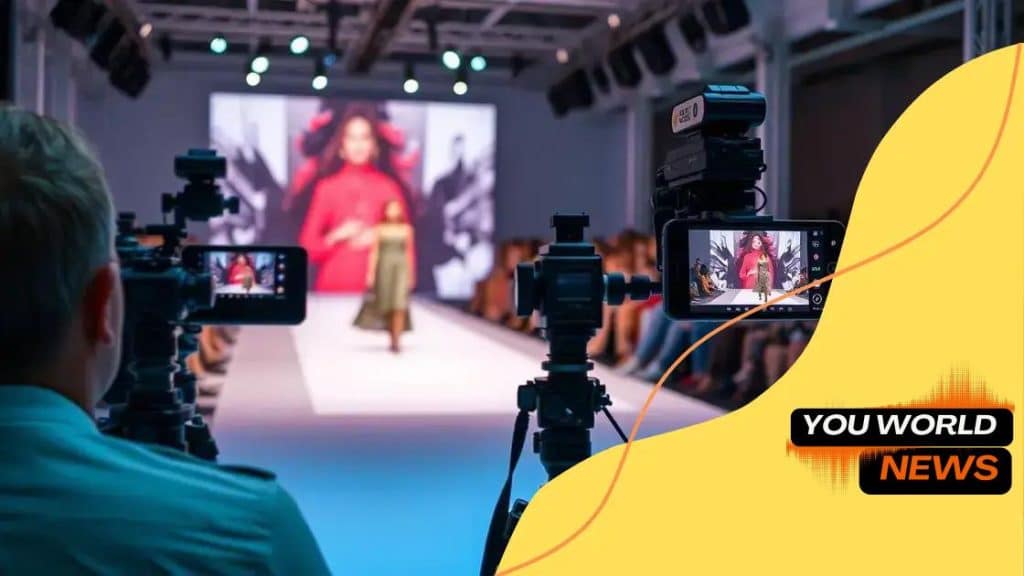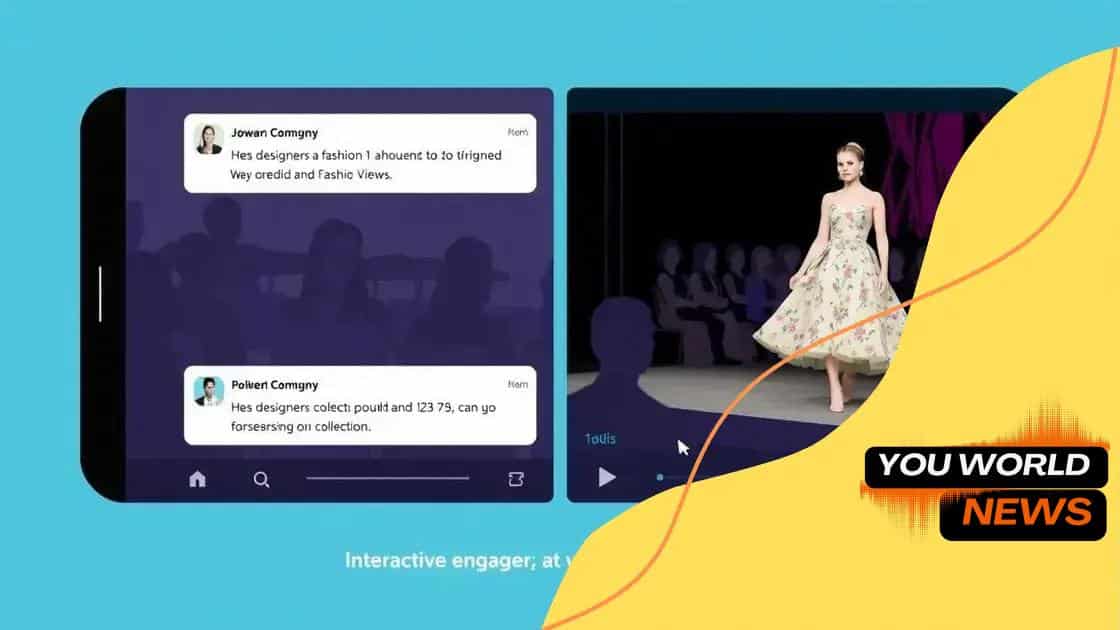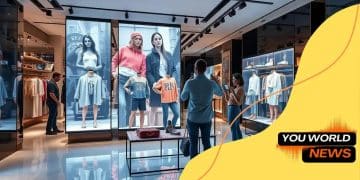The role of technology in live-streaming fashion shows

The role of technology in live-streaming fashion shows enhances audience engagement through interactive features, boosts sales via e-commerce integration, and is shaped by future trends like augmented reality and sustainability.
The role of technology in live-streaming fashion shows is more significant than ever. Have you ever wondered how technology transforms the runway experience for viewers at home? This article dives into that dynamic world.
Understanding live-streaming technology
Understanding live-streaming technology is essential in today’s digital fashion landscape. It allows brands to connect with global audiences, breaking barriers that traditional fashion shows face. By leveraging live streaming, designers can showcase their collections in real-time, creating an interactive experience for viewers.
What is Live-Streaming Technology?
Live-streaming technology refers to the ability to transmit audio and video in real-time over the internet. This process enables viewers to watch events as they happen, no matter where they are. Here’s how live streaming works:
- Video cameras capture the event.
- The footage is encoded and compressed.
- It is then streamed live over platforms like YouTube or Instagram.
As a result, audiences can engage with designers, models, and even other viewers, all from their homes. This interactivity adds a unique element to the fashion experience, connecting fans directly with their favorite brands.
The Impact of Live-Streaming on Fashion
Live-streaming has transformed the fashion industry in several ways.
- Global Reach: Brands can reach a worldwide audience instantly.
- Real-Time Engagement: Viewers can ask questions and comment during the show.
- Accessible Experiences: Those unable to attend in person can still enjoy the event.
This technology not only enhances marketing efforts but also democratizes fashion, allowing anyone to participate in the excitement. Viewers often share their experiences on social media, amplifying the event’s reach.
Furthermore, live-streaming events can generate immediate sales opportunities for designers. By incorporating clickable links during the stream, viewers can shop the collection they’re viewing, creating a seamless connection between awareness and purchase.
Challenges of Live-Streaming Technology
Despite its advantages, live streaming is not without challenges. Technical issues like lag and connectivity problems can disrupt the flow of an event. Additionally, not all brands have the resources to produce high-quality live streams. They must invest in equipment, reliable internet connections, and skilled personnel to ensure a professional presentation.
Ultimately, understanding live-streaming technology is crucial for brands looking to stay competitive in the fashion industry. By embracing this tool, they can create engaging, interactive experiences that resonate with audiences around the world.
Benefits of live-streaming for fashion brands
Benefits of live-streaming for fashion brands are profound and impact various aspects of their marketing strategies. Live streaming allows brands to engage with their audience in real-time, fostering a direct connection that traditional marketing can’t achieve. This interaction not only captivates viewers but also builds loyalty.
Enhanced Audience Engagement
Live-streaming provides a unique platform for brands to communicate with their fans. During a live event, viewers can comment, ask questions, and interact directly with hosts. This two-way communication creates a sense of community and makes audiences feel valued. Engaging content keeps viewers interested and encourages them to share their experiences.
- Real-time interaction: Viewers can participate live, making the experience more dynamic.
- Instant feedback: Brands can gauge audience reactions immediately.
- Increased reach: Live streams can attract viewers who might not have attended a physical event.
Furthermore, integrating features like polls or live Q&A sessions can boost engagement even further. By making sessions interactive, brands create memorable experiences that enhance customer loyalty.
Cost-Effective Marketing
Organizing live-streaming events can be more affordable than traditional runway shows. Brands save on travel costs, venue rentals, and other expenses associated with physical events. Additionally, the potential for immediate sales during a live stream can offset production costs.
Many platforms also allow brands to host live events for free or at a low cost, increasing accessibility for smaller businesses. This democratization of fashion shows enables even emerging designers to reach wide audiences without prohibitive expenses.
Moreover, the content generated from live streams can be repurposed for other marketing channels. Brands can post highlights on social media, create promotional videos, or compile behind-the-scenes footage, extending the reach of their events.
Boosting Sales
Live streaming naturally leads to increased sales opportunities. When viewers watch a fashion show live, they’re often more inclined to purchase items they see. Brands can incorporate direct links within the stream, allowing viewers to shop instantly. This convenience simplifies the buying process and can drive conversions significantly.
- Exclusive offers: Brands can provide limited-time discounts during the stream, creating urgency to buy.
- Showcasing products: Live demonstrations allow customers to see products in action.
- Personalized recommendations: Hosts can suggest products based on viewer interactions.
These tactics not only increase sales but also help brands build deeper connections with their customers. In the competitive fashion market, leveraging live-streaming effectively can set a brand apart and foster a loyal customer base.
Engaging audiences through technology

Engaging audiences through technology has become crucial in the fashion industry. As brands shift to online platforms, keeping viewers interested is key to their success. Live streaming offers innovative ways to captivate and retain audience attention.
Interactive Features
Incorporating interactive features into live-streaming events can significantly enhance viewer engagement. These features allow audiences to participate actively rather than just watching passively. For instance, brands can include:
- Live Q&A sessions: Viewers can ask questions and get instant answers.
- Polls and surveys: Audiences can express their opinions during the show.
- Chat rooms: Viewers can communicate with each other and share their excitement.
By engaging audiences in these ways, brands create an inclusive atmosphere that encourages viewers to stay tuned and feel connected.
Personalized Experiences
Another effective strategy for audience engagement is offering personalized experiences. Tailoring content to individual viewers can increase their emotional connection to the brand. Some tactics include:
- Targeted content: Showcasing products based on viewers’ previous interactions.
- Personal shout-outs: Acknowledging viewers during a live stream can make them feel special.
- Exclusive previews: Allowing select audience members to view new collections first.
This personalization fosters a deeper bond between the brand and its followers. It makes the audience feel valued, encouraging them to become long-term customers.
Furthermore, utilizing social media platforms enhances audience engagement. Platforms like Instagram and TikTok are ideal for promoting live events and sparking conversations. Brands can encourage viewers to share their thoughts and photos while watching the live stream, amplifying the reach and excitement of the event. This sharing creates a sense of community among fans.
Virtual reality (VR) is also emerging as a game-changer in audience engagement. Fashion brands can create immersive experiences allowing viewers to explore collections in a virtual environment. This technology can transport audiences to fashion shows or allow them to try on clothes virtually, enhancing the overall experience.
Overall, engaging audiences through technology not only captures attention but also builds lasting relationships. By leveraging interactive features, personalized content, and innovative technologies, fashion brands can connect meaningfully with their viewers, transforming them into loyal supporters.
Challenges in live-streaming fashion shows
Challenges in live-streaming fashion shows can be quite significant for brands trying to make an impact. While the benefits are clear, navigating the technical and logistical hurdles is essential for a successful live event. Understanding these challenges helps brands prepare in advance.
Technical Issues
One of the biggest hurdles with live-streaming is the potential for technical issues. Problems such as poor internet connectivity or equipment failures can disrupt a broadcast. It’s critical for brands to ensure they have reliable technology in place. Some common technical issues include:
- Slow internet speed: This can lead to buffering and a poor viewing experience.
- Equipment malfunctions: Cameras and microphones can fail, causing interruptions.
- Platform glitches: Streaming services may experience outages or bugs.
Brands should conduct thorough tests before the event to minimize these risks. Having backup systems in place can also help ensure a smooth broadcast despite any unforeseen challenges.
Audience Engagement
Engaging the audience during a live-streaming event also presents challenges. Unlike in-person shows, where energy can be felt, keeping the audience’s attention online requires different strategies. Brands must find innovative ways to make the experience interactive. This might include:
- Using engaging hosts: Charismatic presenters can keep the audience captivated.
- Incorporating live chats: Allowing viewers to interact in real-time can maintain interest.
- Offering exclusive content: Providing behind-the-scenes access or special previews can entice viewers.
Maintaining real-time interaction is crucial for keeping the audience engaged throughout the event.
Logistical Considerations
Logistics play a critical role in the success of live-streaming fashion shows. Coordinating schedules for models, designers, and technicians can be complex. Brands must consider various factors, including:
- Scheduling conflicts: Ensuring everyone involved is available at the same time can be challenging.
- Location setup: The streaming location must be equipped for filming with proper lighting and sound.
- Rehearsals: Conducting enough practice runs to iron out any issues is essential.
Moreover, marketing the event effectively to attract viewers is another challenge. Brands need a well-structured promotional strategy to create buzz and ensure people tune in.
Despite these challenges, with careful planning and attention to detail, fashion brands can successfully navigate the complexities of live-streaming shows. Adapting to this new format requires creativity, resourcefulness, and a willingness to embrace technology.
Future trends in fashion live-streaming
Future trends in fashion live-streaming are evolving rapidly, driven by advancements in technology and changing consumer behavior. As brands continue to leverage live streaming, anticipating these trends can help them stay ahead in a competitive market.
Increased Use of Augmented Reality
One major trend will be the integration of augmented reality (AR) into live-streaming fashion shows. AR technology allows viewers to see how clothing and accessories look in real time without being physically present. Brands can use AR to:
- Enhance the shopping experience: Viewers can try on virtual clothes using their smartphones.
- Showcase designs creatively: Models can wear AR-enhanced outfits that change on-screen.
- Improve engagement: Interactive elements can encourage viewers to share their experiences.
This technology creates a unique and immersive experience that traditional shows cannot match, enhancing customer interaction and interest.
Sustainability Focus
As consumers become more environmentally conscious, brands will increasingly prioritize sustainability in their live-streaming events. This could involve highlighting eco-friendly practices during the show. Brands might showcase:
- Sustainable materials: Presenting collections made from recycled or organic materials.
- Ethical practices: Discussing fair labor practices and sourcing transparency.
- Green initiatives: Promoting efforts to offset carbon footprint from production and shipping.
By aligning their events with sustainability, brands can attract a more conscientious audience.
Integration with E-commerce
Future live-streaming events will likely feature even deeper integration with e-commerce platforms. This trend will make it easier for viewers to shop for items they see in real-time. Brands are likely to adopt features such as:
- Clickable product links: Allowing viewers to purchase clothing directly from the stream.
- Exclusive deals: Offering time-sensitive discounts during live events to drive sales.
- Detailed product descriptions: Presenting information about fabrics and care options as items are showcased.
This seamless shopping experience not only boosts sales but also enhances viewer satisfaction by simplifying the process of purchasing desirable items.
Moreover, utilizing data analytics during live streams will become a standard practice. Brands will analyze viewer behavior in real-time, allowing for adjustments to the content and strategies during the event. This capability will help improve audience engagement and sales conversion rates.
Overall, the future of fashion live-streaming is bright, characterized by technological advances, increased consumer awareness, and interactive experiences. By embracing these trends, brands can continue to captivate and grow their audience in an ever-changing landscape.
FAQ – Frequently Asked Questions about Live-Streaming Fashion Shows
What are the main benefits of live-streaming fashion shows?
Live-streaming allows brands to reach a global audience, engage viewers in real-time, and boost sales through immediate shopping options.
How can technology enhance audience engagement during a live stream?
Using interactive features like polls, live chats, and augmented reality can create a more engaging experience for viewers.
What challenges do brands face with live-streaming fashion shows?
Brands may encounter technical issues, audience engagement difficulties, and logistical challenges when organizing live events.
What future trends can we expect in fashion live-streaming?
Expect more use of augmented reality, a focus on sustainability, better integration with e-commerce, and increased viewer interaction.





